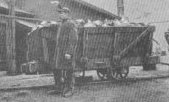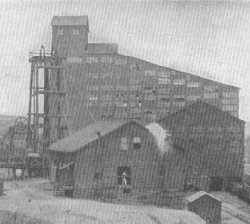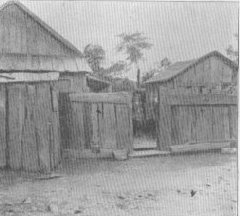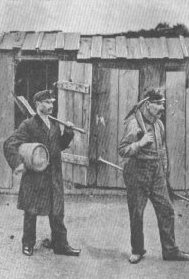Coal mining is hazardous, and the loss of life, by accident, in the mines of the United States averages eight per day. This is not to be wondered at, for, deep in the bowels of the earth, thousands upon thousands of men are working day and night, mining the coal which is an essential factor in the industrial activities of the world.
The amount of wood burned for fuel has been greatly decreased, owing to the deforesting of large areas, and a greater demand upon the coal bearing regions has resulted. The settlement of our vast prairie states, where cold rules throughout a long winter, has likewise shared in stimulating coal mining. To-day we note the enormous growth of manufacturing enterprises and the extension of railway systems. These alone mean much to the coal mining industry. In days gone by, scientists expressed alarm over the threatened exhaustion of the world's coal supply. And yet it appears true that the economical utilization of coal through improvements in power application, will more than counterbalance the increased consumption of this essential fuel, and after all, nature will preserve a balance in some way.
Under such conditions as these, thus briefly outlined, it seems a needless anxiety to concern ourselves to-day, with the possible exhaustion of the world's fuel supply in the course of a dozen centuries. The first use of coal for industrial purposes in England was in the year 1234. After more than 100 years England still leads in the production of coal, being the only country exceeding the United States, in this respect. The annual output of coal in Great Britain is more than 200,000,000 tons, while that of the United States is approximately 195,000,000 tons. Our American mines, being of more recent development, have not penetrated so deep into the earth as some in the old world. The deepest coal mine known is near Tournay, Belgium, extending 3,542 feet into the earth. The deepest coal shaft in England is in the Dunkirk mine, of Lancashire, which is 2,824 feet deep. Pennsylvania leads in the matter of coal production in the United States. Its total product is always more than half that of the entire American yield from all the mines, and exceeds annually 105,000,000 tons. So commanding is this industry in the Keystone State that the popular mind always associates the state with the product, and Pittsburg has gained the name of the "Smoky City" on account of the great manufactories and mines operating in its vicinity. Coal was first discovered in the Schuylkill district in 1790. Thirty years later the first shipment was made to Philadelphia. Two kinds of coal are mined, anthracite and bituminous, or, more popularly speaking, hard and soft coal. The area from which the former is produced measures less than 500 square miles, and that of the soft coal, nearly 9,000 square miles, but the former excels the latter in tonnage produced, and by its greater value per ton, which is more than double that of the latter. The process by which the coal is mined is an interesting one. Down deep in the earth stands a grimy miner. He is dressed in homespun clothes, and upon his head is a small cap, to which is attached a small lamp. This light throws a faint gleam around him and permits him to see the black walls against which his efforts are being directed. The lamp, which rests upon the peak of the cap of the miner, is the invention of Sir Humphrey Davy, and is so constructed as to prevent explosion.
One of the greatest dangers the coal miner has to guard against is the explosion of fire-damp, which may at any time be set off by a single tiny spark. It would therefore be impossible to use an engine that has a fire-box. The machinery of these engines is different from that of any other locomotives. The air supply is gained from great tanks carried over the driving wheels. These tanks have a storage capacity of 600 pounds to the square inch, from which 200 pounds working pressure is maintained upon the engine cylinders. The supply can be readily replenished with nozzles attached to high pressure pneumatic tubes, placed at points convenient for this purpose. When the coal reaches the surface, either by tunnel or shaft, it passes rapidly through a series of processes necessary to clean it, sort it into various sizes or grades for the market, and bring it to the railway cars by which it is to be shipped to its destination. In a great coal "breaker," there is much noise and plenty of dust. There are rickety sheds, inclined planes, screens and chutes, without number. The loaded cars right from the mines reach the breaker high in the air, and are tilted so that they dump their cargo into chutes provided for that purpose. As the coal rattles down through the winding way provided for it, the various chutes sort the grades and sizes, and when it reaches the bottom it falls into bins or coal dumps and is ready for the market. In preparing for the market, the "breaker-boy" plays an important part, for it is he who stands guard and removes each piece of slate from among the coal. The "breaker-boy," or coal picker, gets his first lessons in mining by sorting out the slate. The miners in many of our mining districts are foreigners, with but little education, and it is this class of labor which forms one of the most difficult problems to deal with. In the transportation of coal from mine to market, many of the great railways find their greatest revenue. In Pennsylvania, are a number of railroads which control the output of the mines, and it was these roads that, during the strike of 1902, held out so long against the demands of the miners. Hundreds of trains are run daily from the coal fields to the great manufacturing cities of that region. Much of the coal output of the Keystone State is converted into coke for use in steel mills and manufactories. It is thus, that the coke furnaces become a part of the coal industry, and they have accordingly grown to enormous proportions. The manufacture of coke is now in an almost perfect process. The mechanical appliances used have been improved, so that, virtually, all the work from the mine to the railway car can be carried on by machinery. The coke is drawn from the furnaces where the coal has undergone the charring process, by an ingenious mechanism which works like a great iron hand, on the end of a long steel arm, This is carried on a heavy car, which runs back and forth on a railway track, in front of the row of furnaces. An engine mounted on the same car operates the gigantic hand. Afterward, the coke is raked into a iron trough, where an endless chain or belt carries the product direct into cars, ready for shipment. Pennsylvania is in the lead, with a record of being able to furnish half of the total yield of coal for the United States, and practically all of the anthracite. Illinois follows, a close second, with a total of 20,000,000 tons of bituminous coal; and West Virginia is in third place. Other states in which the coal industry has assumed large proportions, are Ohio, Indiana, Virginia, Iowa, Missouri and Colorado. NEW METHOD OF FATTENING POULTRY |



